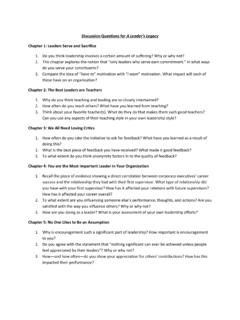Transcription of What Every Leader Needs to Know About Follow ers
1 The distinctions among followers are Every bit as consequential as those among leaders and have critical implications for how managers should manage. What Every Leader Needs to Know About Followers by Barbara Kellerman There is no Leader without at least one era of atter, networked organizations and follower that's obvious. Yet the modern cross-cutting teams of knowledge workers, it's leadership industry, now a quarter-century not always obvious who exactly is following COPYRIGHT 2007 HARVARD BUSINESS SCHOOL PUBLISHING CORPORATION. ALL RIGHTS RESERVED. old, is built on the proposition that leaders (or, for that matter, who exactly is leading). matter a great deal and followers hardly at all. and how they are going About it. Report- Good leadership is the stuff of countless ing relationships are shifting, and new courses, workshops, books, and articles.
2 Ev- talent-management tools and approaches eryone wants to understand just what makes are constantly emerging. A con uence of leaders tick the charismatic ones, the re- changes cultural and technological ones in tiring ones, and even the crooked ones. Good particular have in uenced what subordi- followership, by contrast, is the stuff of nearly nates want and how they behave, especially nothing. Most of the limited research and in relation to their ostensible bosses. writing on subordinates has tended to either It's long overdue for leaders to acknowl- explain their behavior in the context of lead- edge the importance of understanding their ers' development rather than followers' or followers better. In these next pages, I explore mistakenly assume that followers are amor- the evolving dynamic between leaders and phous, all one and the same.
3 As a result, we followers and offer a new typology for deter- hardly notice, for example, that followers who mining and appreciating the differences tag along mindlessly are altogether different among subordinates. These distinctions have from those who are deeply devoted. critical implications for how leaders should In reality, the distinctions among followers lead and managers should manage. in groups and organizations are Every bit as consequential as those among leaders. A Level Playing Field This is particularly true in business: In an Followers can be de ned by their behavior . harvard business review december 2007 page 1. This document is authorized for use only by DENNIS JAKOBSEN Copying or posting is an infringement of copyright. Please contact or 800-988-0886 for additional copies. What Every Leader Needs to Know About Followers doing what others want them to do.
4 But for position as an indicator of who is really the purposes of this article, and to avoid con- leading and who is really following. fusing what followers do with who they are, I. de ne followers according to their rank: They Types of Followers are low in the hierarchy and have less power, Over the years, only a handful of researchers authority, and in uence than their superiors. have attempted to study, segment, and speak They generally go along to get along, particu- to followers in some depth. To various de- larly with those in higher positions. In the grees, Harvard Business School professor workplace, they may comply so as not to put Abraham Zaleznik, Carnegie Mellon adjunct money or stature at risk. In the community, professor Robert Kelley, and executive coach they may comply to preserve collective sta- Ira Chaleff have all argued that leaders with bility and security or simply because it's the even some understanding of what drives their easiest thing to do.
5 Subordinates can be a great help to them- History tells us, however, that subordinates selves, their followers, and their organizations. do not Follow all the time. As the ideas of the Each researcher further recognized the need Enlightenment took hold in the eighteenth to classify subordinates into different types. century, for instance, ordinary people (in in- (See the sidebar Distinguishing Marks: Three dustrialized societies especially) became less Other Follower Typologies. ). dependent on kings, landowners, and the like, Zaleznik classi ed subordinates into one of and their expectations changed accordingly four types according to two sets of variables . as did their sense of empowerment. The dominance versus submission and activity ver- trend continues. Increasingly, followers think sus passivity. His research ndings intended to of themselves as free agents, not as depen- inform corporate leaders in particular.
6 By dent underlings. And they act accordingly, contrast, Kelley and Chaleff were more inter- often withholding support from bad leaders, ested in the welfare of those lower down the throwing their weight behind good ones, and corporate ladder. Their work was designed to sometimes claiming commanding voices challenge and counteract what Kelley called for those lower down in the social or organi- the leadership myth the idea that leaders zational hierarchy. are all-powerful and all-important. Witness the gradual demise of communism Kelley classi ed subordinates into ve types (and totalitarianism) in the former Soviet according to their levels of independence and Union, Eastern Europe, and now China. And activity, but his special interest was in foster- consider the social and political upheavals, all ing exemplary followers those who acted of them antiauthority, in the United States with intelligence, independence, courage, and elsewhere during the 1960s and 1970s.
7 And a strong sense of ethics. These individu- Similarly, there has been a dispersion of als are critical to the success of all groups and power at the highest levels of American busi- organizations, he argued. Meanwhile, Chaleff ness, partly because of changes in the cultures placed subordinates into one of four catego- and structures of corporations as well as the ries based on the degree to which the follower advance of new technologies. CEOs share supports the Leader and the degree to which power and in uence with a range of players, the follower challenges the Leader . including boards, regulators, and shareholder All three did pioneering work and yet, as activists. Executives at global companies must indicated, it seems to have had little impact Barbara Kellerman is the James monitor the activities of subordinates situ- on how current Leader -follower relationships MacGregor Burns Lecturer in Public ated thousands of miles away.
8 And knowledge are perceived. In part, this is because of Leadership at the Center for Public workers can choose independently to use cultural, organizational, and technological Leadership at Harvard University's John collaborative technologies to connect with changes that have taken place in just the past F. Kennedy School of Government in colleagues and partners in other companies few years. Manual laborers, for instance, have Cambridge, Massachusetts. This article and countries in order to get things done. The been replaced by younger, tech-savvy knowl- is adapted from her latest book, Follow - result is reminiscent of what management edge workers, who are generally less disposed ership: How Followers Are Creating sage Peter Drucker suggested in his 1967 book to be, in Zaleznik's parlance, masochistic . Change and Changing Leaders, due in The Effective Executive: In an era dominated by or withdrawn.
9 February 2008 from Harvard Business knowledge workers rather than manual work- The most important point of all these ty- School Press. ers, expertise can and often does trump pologies, however, is that Leader -follower harvard business review december 2007 page 2. This document is authorized for use only by DENNIS JAKOBSEN Copying or posting is an infringement of copyright. Please contact or 800-988-0886 for additional copies. What Every Leader Needs to Know About Followers relationships, no matter the situation, culture, cause, regardless of context, it's the follower's or era in which they are embedded, are more degree of involvement that largely determines similar than they are different. Underlying the nature of the superior-subordinate rela- them is some sort of dominance and some sort tionship. This is especially true today: Because of deference.
10 Segmenting followers, then, of the aforementioned changes in the cultures serves at least two broad purposes: In theory, and structures of organizations, for instance, it enables us all to impose an order on groups knowledge workers often care as much if and organizations that up to now has been not more About intrinsic factors the quality largely lacking. In practice, it allows superiors of their interpersonal relationships with their and subordinates alike to discern who in superiors, for instance, or their passion for the group or organization is doing what the organization's mission than About ex- and why. trinsic rewards such as salary, titles, and other bene ts. A New Typology A typology based on a single, simple The typology I've developed after years of metric as opposed to the multiple rating study and observation aligns followers on one, factors used by the creators of previous seg- all-important metric level of engagement.








